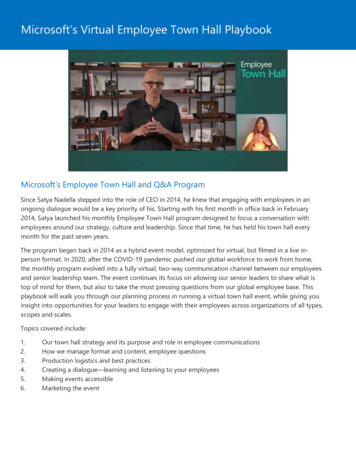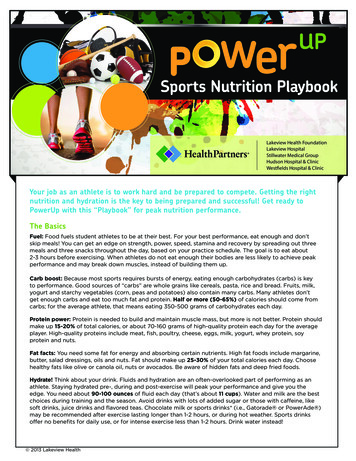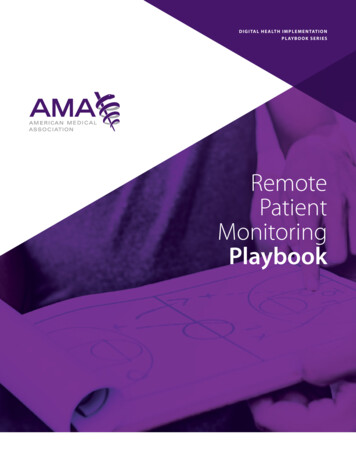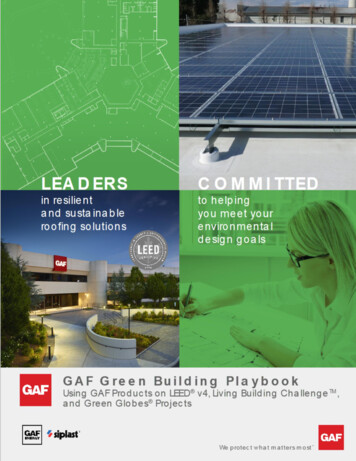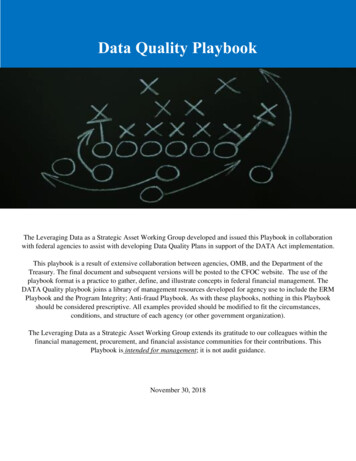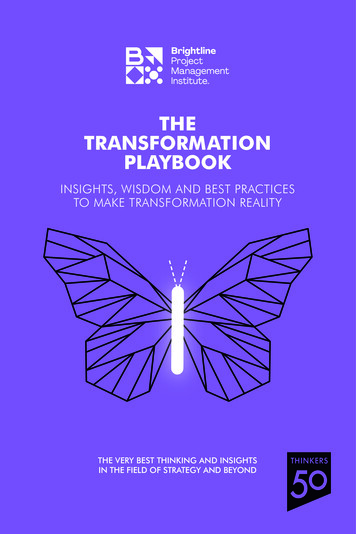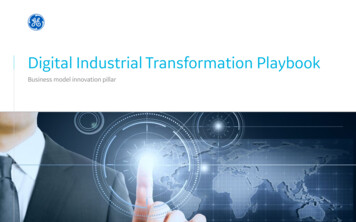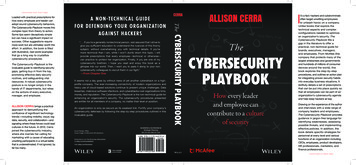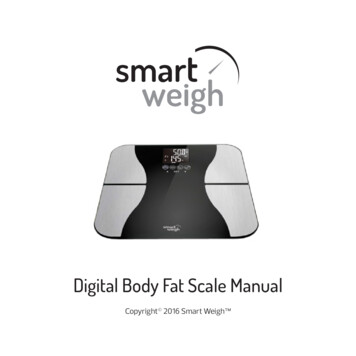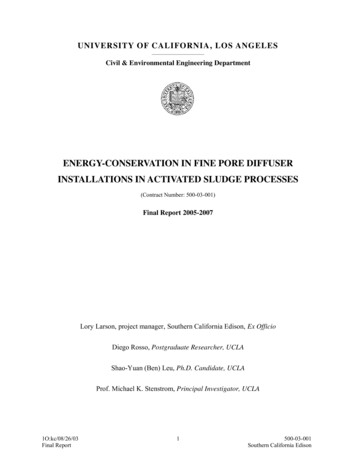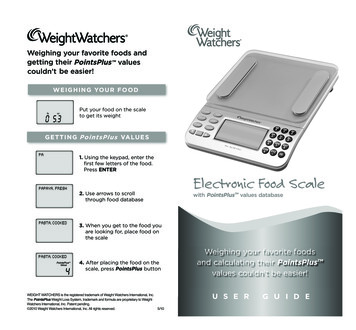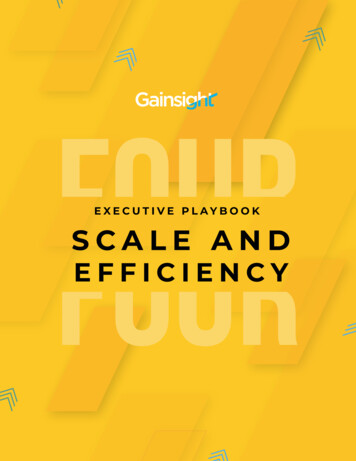
Transcription
EXECUTIVE PLAYBOOKSCALE ANDEFFICIENCY
IF THERE’S AWORD IN BUSINESSVOCABULARY THAT’SUSED MORE OFTENTHAN “CHURN,” IT’SALMOST CERTAINLYTHE WORD “SCALE.”If you want to sound smart in an interview, use the wordscale frequently. “The way we scaled up was ” “I wasresponsible for scaling the org ” “What I would expectit to look like at scale is ” You can’t go wrong using theword scale properly.There’s truth to the influence and importance of scale.Scaling is critical to every business, even if it’s notsomething that happens to everyone. All companiesbegin with the idea that they’ll build something great.However, when they reach a tipping point, their primarychallenge will be scaling it.
4WHAT’S COVEREDIN BOOK FOUR?What is scale?.4Scaling in customersuccessTechnology is the key.5.7Long-tail CSMs.13High-touch.15Mid-touch.18
WHAT IS SCALE?Scaling is just a consultant’s way of saying, “get big.”In reality, however, it’s not only about this type oftremendous growth. Scaling is about getting big in anefficient way. If you had unlimited funds and even adecent product, you could definitely get big. Outspendeveryone on marketing. Blanket the world with salescoverage. Go massive on post-sales support and growth.It wouldn’t be that hard. Of course, no board or investorwould approve that. There are financial limits to thecost of scaling, and that’s why the word “scaling” reallyneeds to be combined with the word “efficiency.”Writing a book on how to scale with unlimited fundswouldn’t be difficult. It would not sell well, though, ifat all. Writing a book on how to scale efficiently on theother hand—that’s a best-seller. Though, honestly, thereare many books already written on this topic. Scalingis tough because every business is different. Therefore,most ivory tower theories fall apart in practice.Over a career you may find that the only business booksworth reading are those written by someone who hasbeen in the trenches. Those with their sleeves rolled upsolving the serious and complicated problems. “TheHard Thing About Hard Things” by Ben Horowitz comesto mind. It’s straightforward with no punches pulled.The approach he gives is honest. Here’s our situation.Here’s what we did. These were the consequences, andhere were the results. It sounds simple, but advice onscaling has no credibility or value unless you’ve lived it.Ben’s book is strongly recommended. What he and theOpsware team survived and turned into a success story,is truly phenomenal.
SCALING INCUSTOMER SUCCESSLet’s talk about customer success and what it meansto scale it with efficiency. There is a phrase often usedin conversations with other CEOs, “Your churn rate isyour choice.” It’s the truth. Assuming you are building aproduct with real value, and almost all of them do, youcan mitigate churn by spending money. If we start atthe ridiculous extreme, you can begin by assigning threesenior CSMs to every single one of your customers. If youdid, what would your churn rate be? It probably wouldbe close to zero. Of course, you can’t do that because thehuman capital or labor cost is far too expensive.This example is an uncomplicated way of establishingthat, just like every other organization or companyinitiative, you have to think about it in the context of afinancial model. In the long run, nothing can escape theneed to be financially viable within the overall business.When someone asks how to scale customer success,what needs to be said is “efficiently.”Many of you have perhaps seen the Gainsight pyramidseveral times. It remains an excellent way to thinkabout and formalize the customer part of your business.(Example on next page)
HIGH TOUCHMID TOUCHTECH TOUCHThe segments in the illustration are what drive yourfinancial model. They are also necessary to helpdetermine how to scale efficiently. The simple premiseis that you can’t afford to treat all your customers thesame unless you want to treat them all poorly. In whichcase it won’t cost very much. Even if you haven’t doneit formally, you are almost certainly thinking abouttreating your customers this way.If your annual subscription price (ASP) is 50K and youhave a 1M customer, it’s for sure you are not treatingthem in the same manner as you do a 50K customer.Nor should you. That’s why the segments in our pyramidare labeled by their touch model. It would help if youthought about scaling from this same perspective. Youcertainly can’t scale tech touch in the same way youscale your most valuable customers.
TECHNOLOGY ISTHE KEYThe universal truth about scaling is that technology is thekey. After all, the primary purpose of technology is to solvebusiness problems, and tech companies are already solving issues you know about. But what about the problemsyou don’t know you have? The truth is most tech companies believe that they are already fixing hidden and futureissues. There are others that are figuring out solutions toproblems you are not solving or are not solving efficiently.In other words, everyoneis trying to build a “better”mousetrap. Part of the“better” is the technologySo our discussion about scaling efficiently, by definition,has to include how technology fits in. Let’s look at thismore closely for each segment, starting with Tech Touch.TECH TOUCHBeginning with the tech-touch segment is logical because it’s often the area of business that people are thinking about when they ask about scaling. The long-tail ofcustomers is a feature of SaaS companies and is a challenging problem to deal with. It is because the long-tailis usually a large number of customers who aren’t payingyou very much. In the case of a freemium offering, theymay not be paying you anything at all.
How do you scale customer success efficiently to a largenumber of customers who, individually, aren’t payingyou very much money? It’s not by assigning some junior CSMs to that segment, hoping that things work out.Which, by the way, is how many companies have tried toattack this problem. However, the most common method of dealing with this challenge is even worse—ignorethem. That won’t yield great results.One certainty worth mentioning here is that anythingyou do to better deal with the low-end segment of yourcustomer base will yield benefits for all of your CSMs andall of your customers. The reverse equation does not work.Things that help your highest-touch customers are unlikely to be useful, or even applicable, to your lower touchcustomers.All of this leaves us with a simple, though difficult, solution for your long-tail of customers. We often refer to thatsolution as “one-to-many.” You can’t afford to work withthese smaller customers one-on-one, so you need to develop programs that touch many at the same time. Almost all of these tactics involve heavy use of technology.Let’s take a look at a few of them:Email Yes, email is as old as technology itself, and we allget WAY too much of it. Still, it can bring value if doneright. What does it mean to do it right? Highly contextual and personalized. To be clear, you can’t just go to yourMarketing team and start sending Marketo emails to allof your customers. With much effort, you could constructsome campaigns, filtered to the right customers, thatwould have some positive impact. What you want to do,however, is automate your emails based on customer success criteria, such as health scores, adoption behaviors,and renewal timing.
The easiest way to think about how to automate emails isto pretend you have enough CSMs to contact all of thesecustomers directly. What would the CSM say? The answer to that question will lead you to your email solution.Construct your email campaigns based on those sametriggers and with the same messaging. This can be a verycomplex procedure. That’s why it requires a sophisticatedemail solution built into your customer success platform,like Gainsight, in order for it to be done optimally.There are a few fundamentals that you will find almost impossible to duplicate in any other system: Personalized - the recipient of the email has toknow that you really know them. Also, the emailscan be created automatically, but you mightwant your CSMs to slightly tweak them andmake them even more personal. Contextual - the emails have to be triggered by adeep understanding of the customer’s behavior.If you had the resources, you would undoubtedlycall a customer whose usage dropped by 40% inthe past month. Well, your emails need to havethat same level of intelligence. Personal - this is different than personalized. Thismessaging means it needs to come from, or atleast can be made to look like it’s coming froma real person, such as a CSM, instead of beingautomated. Now, your customers are smart andwill figure out that these emails are automated.But, if the email is intelligent, helpful, and thereply-to is an actual person, the customer willunderstand and be receptive. Timely - emails don’t have to be in real-time.However, you can’t send an email regarding newfeatures about the latest version, three weeks after the release comes out. That needs to happenthe next day.
In-app engagements This is more leading-edge technology than email, but remember that all of these methodscan work together. However, you can’t just do one. In-appengagements are delivered messages and assistance toyour customer inside your product. They inform users ofsupport issues, give instructions, and even capture customer sentiment. Examples are guides, tutorials, newfeatures announcements, product status messages, andsurveys.Again, much of the technology out there, including Gainsight PX, can help you with this. However, before youinclude in-app engagements in your product, you needto create a charter to ensure your efforts add to the userexperience and not detract from it. These in-app engagements need to be “helpful” and have a purpose. Eachmessage is to deliver more value to a customer’s partnership with you.So when a user comes in for the first time, they get appropriate guidance as a newbie. When they later comeinto your system for the 100th time, you provide appropriate guidance according to their familiarity. At the sametime, you may want every user to see some direction on anew release you shipped yesterday. The real-time, intelligent, in-app guidance is ultimately a super-power for youto manage your long-tail. In addition to adoption advice,you can also use this kind of technology to do surveys atjust the right time. If you do this right, you’ll get a muchhigher response rate than you will via email.Webinars and Podcasts These are the perfect one-tomany channels to deliver appropriate messages andguidance to your customers. Webinars can be tailoredspecifically to the needs of particular customers at certainlifecycle stages. If that sounds familiar, it is. It’s preciselywhat your Marketing team is probably doing with their
marketing automation tool. They target certain levels ofprospects at particular stages of the buying cycle, withvery specific messages designed to nudge them towardspurchase. You may not necessarily be trying to drive purchases with existing customers. What we’re trying to do isdrive behavior that leads to the outcomes we want, whichis retention and upsell.Podcasts tend to be more general but can be extremelyvaluable in the customer success process. One thing thatis often missed in the new recurring revenue equation,which can be nicely addressed in a podcast, is reinforcingthought leadership, product vision, and ROI for existingcustomers. You can think of all these elements as demand generation. The difference is that you are building demand, not for a new product, but for the one theyalready own.User Groups It’s incredibly valuable to get customersinto your user groups. It builds rapport within your community and goodwill for your company. User groups arean excellent way to find and nurture your very best customers. They also help those who are struggling. There’snothing like one customer helping another. When youhave customers collaborating, you know they are building a community around your product, and loyalty goesthrough the roof. User groups are not quite as scalable asthe others because it can’t be automated well. Althoughyou could have meetings virtually, the value would likelybe diminished.Online Community This may be the most underutilizedtool in the customer success toolbox, probably becauseit seems like a heavy lift to get it going. And it is, thoughnot as heavy as you might think. The power of it whenit’s working is incredible. The more customers becomefamiliar with the community, the more empowered and
self-serving they will become. Imagine finding all yourresources in one place and the ability to chat with andhelp other customers. What could be a better indicator ofcustomer loyalty than one customer answering anothercustomer’s “How do I do this?” question?One additional comment on communities: if you have asubset of your lowest customer segment, or perhaps theentire segment that is self-serve, you almost certainlycan’t provide what they need without an online community. It is incredibly valuable for the whole long-tail, andall customers. But it is absolutely a must-have for thosecustomers for whom you can’t provide any personal resources.As you can see, all of these channels or tactics are highlyscalable. Some are almost infinitely scalable if you havein-app messaging or email working in an entirely automated fashion. If you do, you might be able to manageyour entire long-tail with one person.It should be apparent that all of these tactics are applicable to your upper segments, too. Don’t tell me that yourEnterprise CSMs don’t send a lot of repetitive emails totheir customers. At Gainsight, when we rolled out theemail functionality, we did it specifically for our lower tierof customers. But when our Enterprise and Mid-MarketCSMs saw it, they immediately begged for it, too. Withone slight change—emails can be set up to go throughthe CSM for “tweaking,” personalization, or veto beforethey are sent to customers. This is something we refer toas Email Assist. It’s not quite magic, but it’s close.
LONG-TAIL CSMSOne more point that you’ve probably already realizedis that the CSM role for your long-tail is not like yourother CSMs. Their title and goal of retention may be thesame, but the jobs are vastly different. In fact, if you puta long-tail CSM in a room with an Enterprise CSM, they’dhave very little to talk about or in common. One has fivecustomers they speak to every single day. The other has2000 customers with whom they never talk to directly.When you hire someone for this role, take their phoneaway. The whole model breaks down if they start havingone-on-one conversations with their customers.Having the right CSM for your tech-touch segment ismore like having a Marketing person than a traditionalCSM. The channels and tactics they will use are standardtools for marketing such as email, webinars, podcasts,and user groups. They will also be expected to drive thecreation of relevant content for all of these programs.They may not create all of it.Still, someone has tofigure out what the emailsare going to say in everycircumstance,what value and topics the webinars are going to bring tocustomers, and what kind of in-app guidance will have themost value without being annoying. In many ways, this is amarketing role, but it requires the heart and knowledge of aCSM because it’s all about retention.Lastly, do not think about the long-tail CSM as a Junior CSM.The segmentation pyramid is not necessarily a career path.You could easily make the case that an ‘A’ player
running a long-tail program is more valuable than anEnterprise CSM managing your five biggest clients. Youcan find hundreds of smart Account Managers or CSMsout there who would do a great job handling your moststrategic customers. But there are very few in the industrywho have cracked the nut of the long-tail customersegment.
HIGH-TOUCHLet’s jump to the top tier because, like the tech-touchsegment, it’s unique and needs a particular perspective.Not that Mid-Touch doesn’t, but with most thingsthat come in threes, the middle one is usually a grayarea. Sometimes what works for that segment is acombination or adjustment of the other two.Many companies who have primarily large and hightouch customers believe that they don’t need technologyto assist them, or that it’s far less critical than it actuallyis. There’s some truth to that, but it can be misleading.The truth is that, with high-paying, or high-value clients,it does feel like you can throw bodies at any problem. Andyou certainly can. Take, for example, a 5M customer. Thecustomer success rule-of-thumb says you could afford2.5 CSMs on just that one account. So, why not just throwthree CSMs at them? For 5M, it’s worth it because youcan’t afford to lose a customer like that. These are all truestatements but still missing the point.Customer success is all about insurance. In everyday life,we’re willing to pay a high price for insurance to protecta valuable object. But would we pay 1000 to insure a 5M object if we could get the same benefits for half theprice? If we could afford to own something worth 10M,then a 10K policy may not be a financial burden. Butwould you pay the full price if you could get the samebenefits for less? The point is, why pay more than youhave to?
We worry about headcountall the time at every levelbecause it’s the mostvaluable and expensiveresource in our companies.We worry about headcount all the time at every levelbecause it’s the most valuable and expensive resourcein our companies. Remember that the art of customersuccess is getting to your retention numbers for thelowest possible cost. It’s fine to throw bodies at valuablecustomers. Just don’t throw them away. Be judiciousabout how you spend money and people. Consider thenmaking your Enterprise CSMs more efficient, and moreeffective, as well. Technology is always cheaper thanpeople in the long run. And technology can help yourEnterprise CSMs to scale, too.Here are a few examples: Single view of the customer - In Gainsight, we callthis the Customer 360 View. Everyone spends a lot oftime talking with high-value clients. You can makethat client time more profitable if you prepare forevery call. With the 360 view, you have a singlewindow into everything you want and need to knowabout a customer. Instead of searching throughvarious systems for data, you save time and moneywhile gathering institutional knowledge aboutcustomers in one place. Success Plans - A different term could be used here,but this is the right one. Coincidentally, it’s also thename of the associated feature in Gainsight. SuccessPlans is simply an account plan centered around thecustomer’s objectives on which the customer and
the CSM can collaborate. It’s also the centerpiece ofevery executive business review (EBR) because theobjectives should be the ones set at the previous EBR,and reviewing our progress against them is critical.Not unlike objectives and key results (OKRs) for ouremployees. Automated EBR creation - Effective EBRs are criticalfor your largest customers. But preparing for themis a royal pain. Gainsight can help you automate thatprocess. With the click of a button, the charts andreports that you want from inside Gainsight can bepushed into your email template. This action will leaveyour CSM time to spend on the key strategic elementsof the EBR.It’s worth mentioning that everything discussedregarding your long-tail customers applies to yourhigh touch customers. You could also argue that yourlong tail customers are more important. Though theyare a segment of small customers with small revenueper customer, they can create a substantial revenuepercentage. In comparison, each hour of your EnterpriseCSM’s time is more costly than an hour of your TechTouch CSM’s time. In the end, is it as valuable?
MID-TOUCHMid-touch are the customers caught in-between. Theyare the middle child if you will. This segment could be thesweet spot of customer success and often what peoplethink of when they broach the topic of CS. It’s the worldwhere CSMs own 30 to 80 customers. While they maybuild some level of relationship with almost all of them,they never have time to go as deep or know them aswell as they’d like to. In this world, all of the tactics, andtechnology solutions, discussed for Tech-Touch and HighTouch add value. Lots of value.There are a couple more tactics, however, which arecritical and more useful in the Mid-touch CSM’s toolkit:Automated Tasks - At Gainsight, we call these Calls ToActions (CTAs). Other companies may call them alerts.Whatever you call them, they are crucial. They are whatallow us to live up to the phrase “Talk to the rightcustomer at the right time with the right data.” This isthe motion of using data to create an action ofintervention with the customer. These CTAs in Gainsightlive in the CSM’s Cockpit and direct their daily work. Theyare triggered by the rules that are set, so we know whatrequires action. They can be either positive or negative.As a simple example, take an NPS score. If a user gives ascore of 4, they are a Detractor. A CSM is asked tointervene, find out the reason for the low score, and putthem back on track. If another user gives a 9, they are aPromoter. In this case, the CTA might go to theMarketing team to request a case study or add them toour reference database. It’s all data-driven actions. Youcan’t do customer success without them.
Playbooks - A playbook provides step-by-step guidanceon the tasks, or CTAs, that a CSM needs to complete toeffectively manage certain scenarios in the customerjourney, such as an upcoming renewal or a drop inusage. In Gainsight, these also live in the Cockpit forCSMs to see. They provide the best practices for dealingwith whatever situation the CTA represents.To use our previous NPS example, the playbook for theDetractor CTA might look something like this:Review Customer 360 View to get an overview of the clientoCheck the user’s role (Power User, Admin,Decision-Maker) oCheck past history of this user’s NPS responsesoCheck text response, if any, for this surveyoCheck scores from others at the same companyoCheck renewal dateoCheck contract valueCall the customer to close the loop, learn whatever wecan, and create a plan to get them back on trackOne other amazing value about the Gainsight Cockpit,CTAs, and Playbooks is that they serve as an invaluablemanagement tool. As a manager, you look at a CSM’sCockpit and see everything they are working on. You seehow much progress they’ve made, and how many CTAsand Playbook tasks they’ve closed. You can also checkwhether they are on track to their retention goals. It’svery similar to how our VP of Sales uses our CRM to havemuch more data-driven, and valuable conversations withhis Account Execs. It’s an incredible employeemanagement tool, in addition to a customermanagement tool.
Scaling is hard. It’s especially difficult to do efficiently,but it’s doable. The best companies have successfullyscaled their customer success programs, too. But noneof them are successful without the intelligent use oftechnology. The need to scale is simply a cry fortechnology. As we all know, tech is not magic. You don’tjust buy a piece of software, and your problems goaway. The right technology in the right hands is theONLY way to scale efficiently. The tips and tactics sharedhere will get you started on the right path. AndGainsight is here to guide you and help you further asyou need it.
EXECUTIVE PLAYBOOKSCALE ANDEFFICIANCY
Marketing team and start sending Marketo emails to all of your customers. With much effort, you could construct some campaigns, filtered to the right customers, that would have some positive impact. What you want to do, however, is automate your emails based on customer suc-cess criteria, such as health scores, adoption behaviors, and renewal .
